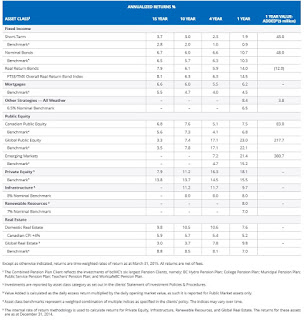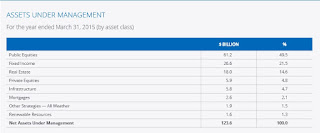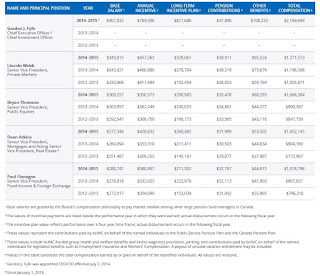Janet McFarland of the Globe and Mail reports, B.C. pension management firm reaps benefits of global markets:
As discussed in the article above, the biggest driver of bcIMC's results in 2014-2015 was this tactical shift into global equities at the end of March 2014. With a little over half of the assets in global public equities, bcIMC benefited from the "beta boost" and decline in the loonie that other large Canadian pensions benefited from as they shifted public and private assets away from Canada.
On page 17 of the Annual Report, there is a detailed discussion on the drivers of public equities:
As shown above, China significantly outperformed other regions (+100%) mostly owing to the brewing bubble there which is now bursting, but there were solid gains in the U.S. and Japan (+29%), especially when you factor in the decline in the Canadian dollar relative to these currencies.
But the gains didn't just come from public equities. The table below from page 14 of the Annual report provides a breakdown of returns by asset class (click on image):
As shown, there were solid gains in Private Equity (18.1% vs 15.5% for its benchmark) and gains in Infrastructure and Renewable Resources were decent but not spectacular (9.7% and 8% respectively vs a 7% nominal benchmark). Similarly, gains in Canadian (+7.6%) and Global Real Estate (+9.8%) were decent relative to its benchmark of CPI+4% (+7%) but not spectacular.
(Note: For some reason, the performance of Private Equity, Infrastructure and Renewable Resources is unaudited whereas the performance of Real Estate is audited. No discussion on why this is the case).
As you can see from the table below taken from page 3 of the Annual report, Private Equity, Infrastructure and Renewable Resources make up roughly 11% of total assets (click on image):
Relative to its larger peers, bcIMC was late shifting assets into private equity, which is why that 5% weighting of total assets will double in the coming years. The bulk of private market assets at bcIMC are in Real Estate, which now accounts for 15% of total assets (it was 18% last year when the loonie was stronger).
In order to better understand and fully appreciate bcIMC's investment approach, I highly recommend you read a March 2014 article from Benefits Canada, How bcIMC is transforming its portfolio, where its former CEO/CIO Doug Pearce goes over their investment portfolio.
In that article, you will read why bcIMC doesn't invest in hedge funds and how it develops greenfield projects in real estate:
The fact that bcIMC's Real Estate portfolio is almost entirely in Canada makes sense from a liability standpoint but it doesn't make sense from a diversification standpoint and returns in that asset class didn't benefit from the decline in the Canadian dollar, which I think will continue as the Canadian economy has turned for the worst.
It is worth noting that the former head of real estate at bcIMC, Mary Garden, has departed the organization. Gordon will be actively looking to replace her as he figures out how to bolster and diversify that asset class.
In his CEO/ CIO report in the Annual Report (starts on page 6), Gordon Fyfe had this to say on enhancing bcIMC's investment strategies:
Finally, the table below from page 36 of the Annual Report provides information on the compensation of bcIMC's senior executives (click on image):
As you you see, Gordon Fyfe enjoyed a total compensation of $2,169,699 in fiscal 2015 after arriving at bcIMC in July 2014, more than twice as much as other senior executives which all made roughly $1 million. Of course, Gordon's compensation was drastically reduced from the good old days at PSP Investments but he's still part of Canada's pension plutocrats and gets to enjoy his millions living in his home town of Victoria, British Columbia where all his family lives.
To be fair, what counts in compensation is long-term performance based on the last four fiscal years and in this regard, bcIMC's senior managers have exceeded their benchmarks. Also, as Gordon Fyfe stated: “To put this into perspective, we returned 8.1% (annualized) against a 10-year combined benchmark of 7.3%. That translates into $6.9 billion in additional value to our public sector pension
clients.”
I congratulate Gordon and the folks at bcIMC for a solid performance in fiscal 2015 but warn them to start reducing their risk to Chinese public equities and even emerging markets (hope they already did). That trade panned out exceedingly well in fiscal 2015 but it will be a total disaster in fiscal 2016.
On the thematic portfolio, I'm still bullish on U.S. biotechs (IBB or XBI) and by extension healthcare (XLV) which has big biotechs among its holdings and continue to add to my positions in each big biotech dip. I continue to steer clear of Canadian equities and all energy/ commodity shares as my fear remains that global deflation will win over global reflation.
On that note, I invite many of you to subscribe via PayPal on the top right-hand side of the blog and choose one of three options: $500, $1000 or $5000. I work hard to provide you with insights on pensions and investments and feel it's appropriate to ask institutional investors to contribute and support my efforts. And that includes you, Mr. Fyfe. If you read me (and you do), you should support my efforts.
Below, following up on bcIMC's quarterly report on Responsible Investing discussing the importance of water, I embedded a 60 Minutes clip where Lesley Stahl reports on disturbing new evidence that our planet's groundwater is being pumped out much faster than it can be replenished. You can view it here if it's hard to see below.
A tactical decision to shift investments into global stock markets paid off last year for British Columbia Investment Management Corp., which earned a 14.2-per-cent return (net of costs) for the year and boosted its total assets to $124-billion.You can view bcIMC 2014-2015 Annual Report here. There is an interactive version and a PDF file. You can also view the press release on these results here.
BCIMC reported it moved more assets into global equities during the fiscal year ended March 31, 2015, while reducing its weighting in fixed income holdings and mortgages, responding to volatility in Canadian stock markets as oil prices declined.
The fund ended the fiscal year with 49.5 per cent of its assets invested in public stock markets, up from 47.6 per cent a year earlier. BCIMC had 21.5 per cent of its holdings in fixed-income securities such as bonds, down slightly from 22 per cent last year, while 14.6 per cent of the portfolio is in real estate, a decline from 17.4 per cent at the end of fiscal 2014.
The fund said its Canadian public equity holdings earned a 7.5-per-cent return last year, while global public equities earned a far higher 23 per cent and emerging markets equities posted 21.4-per-cent gains, illustrating the value of shifting out of Canada’s volatile stock market.
Although the fund adjusted its weightings last year, chief executive officer Gordon Fyfe said it continues to have a long-term investment strategy to ensure member funds are able to deliver pensions to their members.
“Maintaining our discipline, while focusing on due diligence and diversification allows BCIMC to manage market risks so our investments can provide stable cash flows and will appreciate in value over time,” he said in a statement.
BCIMC said investing in passive benchmarks last year would have earned a 12.6-per-cent return, so its active investment strategy added $1.4-billion in additional returns. Over the past 10 years, BCIMC earned an average 8.1-per-cent annualized return, exceeding its benchmark of 7.3 per cent.
BCIMC published its annual report Thursday, showing its executive compensation payments for the past year. Mr. Fyfe, who joined the fund last July, earned $2.2-million in total compensation for the portion of the year he worked, while Lincoln Webb, senior vice-president of private markets, earned $1.27-million in fiscal 2015.
BCIMC oversees investments for B.C. public sector pension plans as well as other government funds. It is Canada’s fourth-largest pension fund manager behind the Canada Pension Plan Investment Board, the Caisse de dépôt et placement du Québec and the Ontario Teachers’ Pension Plan.
As discussed in the article above, the biggest driver of bcIMC's results in 2014-2015 was this tactical shift into global equities at the end of March 2014. With a little over half of the assets in global public equities, bcIMC benefited from the "beta boost" and decline in the loonie that other large Canadian pensions benefited from as they shifted public and private assets away from Canada.
On page 17 of the Annual Report, there is a detailed discussion on the drivers of public equities:
Our emerging markets funds were a key driver of returns in our public equity program. The Active Emerging Markets Equity Fund outperformed the benchmark by 7.2 percentage points. Over a four-year period, the fund returned 7.5 per cent against a benchmark of 4.6 per cent. China and India performed exceedingly well and clients benefited from being overweight to these regions. We continued to increase our exposure to China. bcIMC deployed an additional $200 million into the domestic China A-Share market, which gained 120 per cent last year.The chart below from page 12 of the Annual report shows the breakdown in performance of global equity markets during bcIMC's fiscal 2015 (click on image; total returns all in C$):
Our global equity funds also drove overall returns. The Active Global Equity Fund returned 24.9 per cent against a benchmark of 22.3 per cent. The Thematic Public Equity Fund returned 30.8 per cent against a benchmark of 22.3 per cent. Our exposure to the health care theme was an important driver of the value-added performance.
As shown above, China significantly outperformed other regions (+100%) mostly owing to the brewing bubble there which is now bursting, but there were solid gains in the U.S. and Japan (+29%), especially when you factor in the decline in the Canadian dollar relative to these currencies.
But the gains didn't just come from public equities. The table below from page 14 of the Annual report provides a breakdown of returns by asset class (click on image):
As shown, there were solid gains in Private Equity (18.1% vs 15.5% for its benchmark) and gains in Infrastructure and Renewable Resources were decent but not spectacular (9.7% and 8% respectively vs a 7% nominal benchmark). Similarly, gains in Canadian (+7.6%) and Global Real Estate (+9.8%) were decent relative to its benchmark of CPI+4% (+7%) but not spectacular.
(Note: For some reason, the performance of Private Equity, Infrastructure and Renewable Resources is unaudited whereas the performance of Real Estate is audited. No discussion on why this is the case).
As you can see from the table below taken from page 3 of the Annual report, Private Equity, Infrastructure and Renewable Resources make up roughly 11% of total assets (click on image):
Relative to its larger peers, bcIMC was late shifting assets into private equity, which is why that 5% weighting of total assets will double in the coming years. The bulk of private market assets at bcIMC are in Real Estate, which now accounts for 15% of total assets (it was 18% last year when the loonie was stronger).
In order to better understand and fully appreciate bcIMC's investment approach, I highly recommend you read a March 2014 article from Benefits Canada, How bcIMC is transforming its portfolio, where its former CEO/CIO Doug Pearce goes over their investment portfolio.
In that article, you will read why bcIMC doesn't invest in hedge funds and how it develops greenfield projects in real estate:
With real estate investments—which account for about 18% of bcIMC’s total portfolio—the company focuses on development (buying land and building on it) rather than on purchasing property. “Returns are greater when we develop,” Pearce says, citing high real estate prices as a reason for this approach. “It’s something the larger pension plans can do in Canada.” Currently, bcIMC has 24 development projects across the country, including office, industrial, retail and multi-family apartment buildings.bcIMC's new CEO/ CIO, Gordon Fyfe, is breaking tradition on hedge funds as the "All Weather" strategy on page 14 from table above is an allocation to Bridgewater. Moreover, he will increasingly focus his attention on private markets, which is what he did when he was running PSP Investments.
The company’s real estate holdings are almost entirely in Canada because this is a market that bcIMC understood when it started these investments. But, as the program matures, it will become more international in the future, Pearce says. By contrast, he adds, the majority (77%) of the agency’s infrastructure investments are outside of the country—generally in developed nations, because fewer of Canada’s infrastructure assets have come to market. Together with renewable resources, infrastructure investments make up 6% of bcIMC’s total portfolio.
However, the corporation doesn’t endorse all alternatives. For example, it has always avoided hedge funds.“In B.C., our clients are relatively conservative. Therefore, putting leverage on the portfolio is very limited,” Pearce explains. “[And] we didn’t like the non-transparency of hedge funds.”
The fact that bcIMC's Real Estate portfolio is almost entirely in Canada makes sense from a liability standpoint but it doesn't make sense from a diversification standpoint and returns in that asset class didn't benefit from the decline in the Canadian dollar, which I think will continue as the Canadian economy has turned for the worst.
It is worth noting that the former head of real estate at bcIMC, Mary Garden, has departed the organization. Gordon will be actively looking to replace her as he figures out how to bolster and diversify that asset class.
In his CEO/ CIO report in the Annual Report (starts on page 6), Gordon Fyfe had this to say on enhancing bcIMC's investment strategies:
Ultimately, bcIMC’s goal is to invest our clients’ money and generate value-added returns. Our clients depend on these returns to pay pensions and insurance obligations long into the future. We must ensure our strategies maximize returns within our clients’ risk parameters. To keep pace with the rapid evolution of the investment world, our investment activities will become increasingly sophisticated and adapt to the changing capital markets.The use of leverage and derivatives might pave the way to incorporate risk parity strategies and hedge funds in bcIMC's portfolio (as stated, the "All Weather" strategy on page 14 from table above is an allocation to Bridgewater).
Updating our investment strategies includes expanding our use of derivatives and leverage in our programs to facilitate cost-effective rebalancing of our clients’ portfolios. We view the use of certain derivative products as an efficient tool to reduce the risk of portfolios, as well as to allow for quicker transitions of assets and to produce higher returns. In short, derivatives can benefit our clients. Similarly, leverage allows us to take advantage of low interest rates, and when used as a strategy, can free up capital to be used elsewhere.
We will also increase our global investment footprint and expand our range of products to ensure our clients can benefit from a wider range of investment opportunities. These include expanding our currency management capabilities, increasing global private market investments, and adding high yield debt.
Finally, the table below from page 36 of the Annual Report provides information on the compensation of bcIMC's senior executives (click on image):
As you you see, Gordon Fyfe enjoyed a total compensation of $2,169,699 in fiscal 2015 after arriving at bcIMC in July 2014, more than twice as much as other senior executives which all made roughly $1 million. Of course, Gordon's compensation was drastically reduced from the good old days at PSP Investments but he's still part of Canada's pension plutocrats and gets to enjoy his millions living in his home town of Victoria, British Columbia where all his family lives.
To be fair, what counts in compensation is long-term performance based on the last four fiscal years and in this regard, bcIMC's senior managers have exceeded their benchmarks. Also, as Gordon Fyfe stated: “To put this into perspective, we returned 8.1% (annualized) against a 10-year combined benchmark of 7.3%. That translates into $6.9 billion in additional value to our public sector pension
clients.”
I congratulate Gordon and the folks at bcIMC for a solid performance in fiscal 2015 but warn them to start reducing their risk to Chinese public equities and even emerging markets (hope they already did). That trade panned out exceedingly well in fiscal 2015 but it will be a total disaster in fiscal 2016.
On the thematic portfolio, I'm still bullish on U.S. biotechs (IBB or XBI) and by extension healthcare (XLV) which has big biotechs among its holdings and continue to add to my positions in each big biotech dip. I continue to steer clear of Canadian equities and all energy/ commodity shares as my fear remains that global deflation will win over global reflation.
On that note, I invite many of you to subscribe via PayPal on the top right-hand side of the blog and choose one of three options: $500, $1000 or $5000. I work hard to provide you with insights on pensions and investments and feel it's appropriate to ask institutional investors to contribute and support my efforts. And that includes you, Mr. Fyfe. If you read me (and you do), you should support my efforts.
Below, following up on bcIMC's quarterly report on Responsible Investing discussing the importance of water, I embedded a 60 Minutes clip where Lesley Stahl reports on disturbing new evidence that our planet's groundwater is being pumped out much faster than it can be replenished. You can view it here if it's hard to see below.




